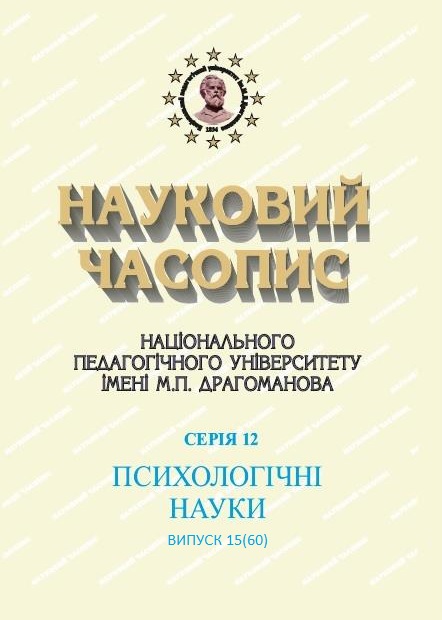PREVALENCE SUBSTANTIATION OF CYBERBULLING MANIFESTATION AMONG STUDENT YOUTH
DOI:
https://doi.org/10.31392/NPU-nc.series12.2021.15(60).03Keywords:
bullying, mobbing, cyberbullying, digitalization of violence, adolescence, student youth.Abstract
The article considers the problem of psychological cyberbullying of student youth in order to substantiate the essence of the phenomenon and the prevalence of its manifestation in the youth environment in higher education institutions. The relevance, insufficient study of the issue and attempts to justify the importance of a scientific approach to this problem have led to the choice of topic, theoretical generalization and analytical review of research that have become the impetus for further empirical research. The research methods were the theoretical analysis of legal and psychological-pedagogical literature on understanding the concepts of bullying, mobbing and cyberbullying, empirical results of diagnosing the prevalence of cyberbullying among the students on the author’s questionnaire, which is based on the study of O. Makarova (2016) “Psychological features of cyberbullying as a form of Internet crime”. The concepts of “bullying” and “mobbing” in the legal and psychological and pedagogical aspects are defined, the use of “cyberbullying” concept for the study of student youth and its prevalence among adolescents is substantiated. The relevance of the problem and the need for further development of theoretical principles and practical research of cyberbullying not only for schoolchildren, but also for adult graduates was established. Peculiarities of cyberbullying manifestations in students and their differences from school violence on the Internet in scientific and practical research are considered. Quantitative data have been obtained and the main tendencies in understanding the problem of digital psychological violence in cyberspace among the students of different specialties and educational-professional programs have been defined. The presence of cyberbullying in various spheres of life of applicants and the frequency of manifestations of the phenomenon among student users of the social network within the institution of higher education have been empirically revealed. This study will be the basis for a theoretical and empirical study of socio-psychological factors of counteraction and means of cyberbullying prevention in the student environment, and will be an impetus for the further development of cyber psychological science in Ukraine.
References
- Averkieva,V. (2020). Psihologicheskie osobennosti vliyaniya kiberbullinga na molodezh [Psycological aspects of cyberbullying impact on adolescents]. In I.A.Ershova, S.B. Malykh, T.N. Tikhomirova (Eds.), Psihologiya obrazovaniya: sovremennyj vektor razvitiya – Psychology of education: modern vector of development, (pp. 454–467). Yekaterinburg : Ural University Publishing House [in Russian].
- Hordiienko, К.О. (2021). Didzhytalizatsiia psykholohichnoho nasylstva studentskoi molodi [Digitalization of psychological violence of student youth]. In L.V.Pomytkina & O.M. Ichanska (Eds.), Aviatsiina ta ekstremalna psykholohiia u konteksti tekhnolohichnykh dosiahnen – Aviation and extreme psychology in the context of technological achievements, (pp. 182-187). Kyiv : “Department”. Retrieved from https://er.nau.edu.ua/handle/NAU/49819 [in Ukrainian].
- Hordiienko, К.О. (2021). Prychyny vynyknennia kiberbulinhu u studentskomu seredovyshchi [Causes of cyberbullying in the student environment]. Proceedings from: IV Vseukr. nauk. internet-konf. (z mizhnarodnoiu uchastiu) “Mediatvorchist v suchasnykh realiiakh: protystoiannia mediatravmi” – IV All-Ukrainian Scientific Internet Conference (with international participation) “Media creativity in modern realities: confronting media trauma” (Kyiv, June 25, 2021). Kyiv : Institute of Social and Political Psychology of NAPS of Ukraine. Retrieved from https://er.nau.edu.ua/handle/NAU/52245 [in Ukrainian].
- Zhdanova, A., & Chernoyarova, N.S. (2015). Vliyanie virtualnoj sredy na socializaciyu sovremennoj molodezhi [The impact of virtual environment on the socialization of today’s youth]. Elektronnoe nauchnoe izdanie Uchenye zametki “TOGU” – Electronic scientific publication "Scientific Notes of PNU", 6 (2), 121–127. Retrieved from http://pnu.edu.ru/media/ejournal/articles-2015/TGU_6_84.pdf [in Russian].
- Lubenets, I.G. (2016). Kibernasylstvo (kiberbulinh) sered uchniv zahalnoosvitnikh navchalnykh zakladiv [Cyberbullying among students of secondary schools]. Natsionalnyi yurydychnyi zhurnal: teoriia i praktyka – National law journal: teory and practice, 3(19), 178–182. Retrieved from http://www.jurnaluljuridic.in.ua/archive/2016/3/38.pdf [in Ukrainian].
- Makarova, E.A., Makarova, E.L., & Mahrina, E.A. (2016). Psihologicheskie osobennosti kiberbullinga kak formy internet-prestupleniya [Psychological features of cyberbullying as a form of internet crime]. Rossijskij psihologicheskij zhurnal – Russian Psychological Journal, 13(3), 293–311 https://doi.org/10.21702/rpj.2016.3.17 [in Russian].
- Naidonova, L.A. (2014). Kiberbulling abo ahresiia v interneti: sposoby rozpiznannia i zakhyst dytyny (metodychni rekomendatsii) [Cyberbullying or aggression on the Internet: ways to recognize and protect the child (guidelines)]. Kyiv : Institute for Social and Political Psychology of NAES of Ukraine [in Ukrainian].
- Petrosyants, R. (2011). Problema bullinga v sovremennoj obrazovatelnoj srede [Bullying in modern school environment]. Vestnik TGPU – TSPU Bulletin, 6 (108), 151–154 [in Russian].
- Romanov,A., Levashova, A.V., Sidenko, K.O., & Mikhailova, E.A. (2021) Sushchnost bullinga kak sotsialno-pravovogo yavleniya [The essence of bulling as a social and legal phenomenon]. Voprosy rossijskogo i mezhdunarodnogo prava – Matters of Russian and International Law, 11 (1А), 98-106. https://doi.org/10.34670/AR.2020.59.72.014 [in Russian].
- Fomichenko, A.S. (2018). Osobennosti proyavleniya kiberbullinga v vysshem obrazovanii (po materialam zarubezhnyh issledovanij) [Features of cyberbulling in higher education (based on foreign researches)]. Internet-zhurnal «Mir nauki» – Internet magazine “World of Science”, 5(6) [in Russian].
- Carney, J., Jacob, C.J., & Hazler, R. (2011). Exposure to school bullying and the social capital of sixth-grade students. Journal of Humanistic Counseling, 50(2), 238–253 https://doi.org/10.1002/j.2161-1939.2011.tb00122.x
- Kota, R., Schoohs, S., Benson, M. & Moreno M.A. (2014). Characterizing cyberbullying among college students: Hacking, Dirty Laundry, and Mocking. Societies, 4(4), 549–560. https://doi.org/10.3390/soc4040549
- Pomytkin, E.O., Pomytkina, L.V., & Ivanova, O.V. (2020). Electronic Resources for Studying the Emotional States of New Ukrainian School Teachers during the COVID-19 Pandemic. Information Technologies and Learning Tools, 80(6), 267–280. https://doi.org/10.33407/itlt.v80i6.4179

